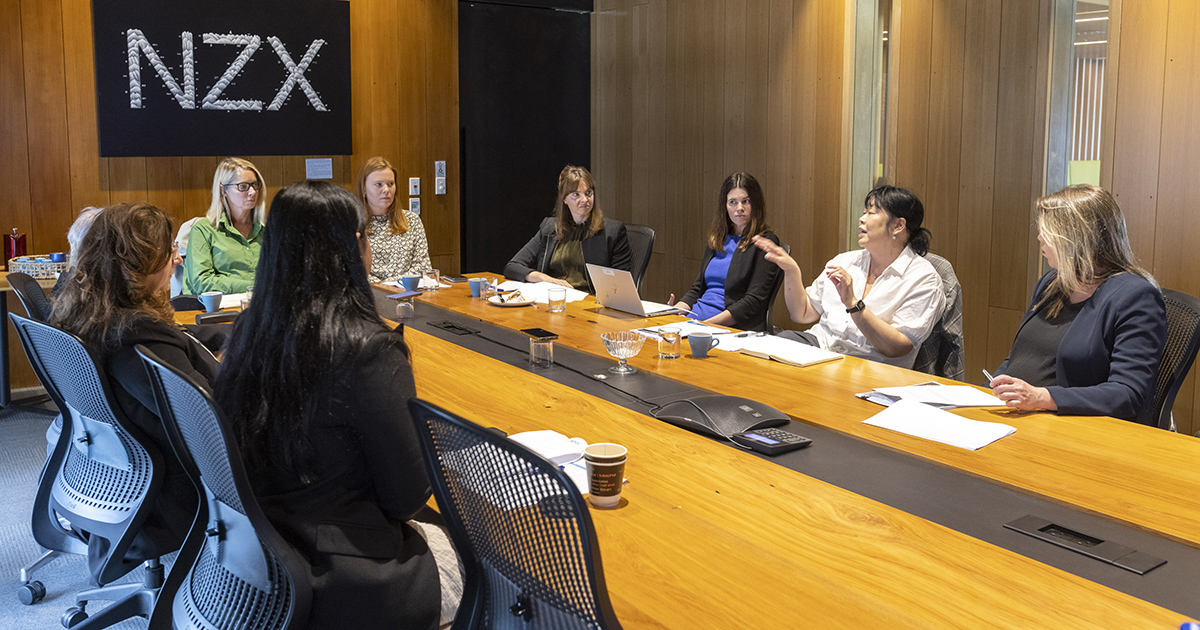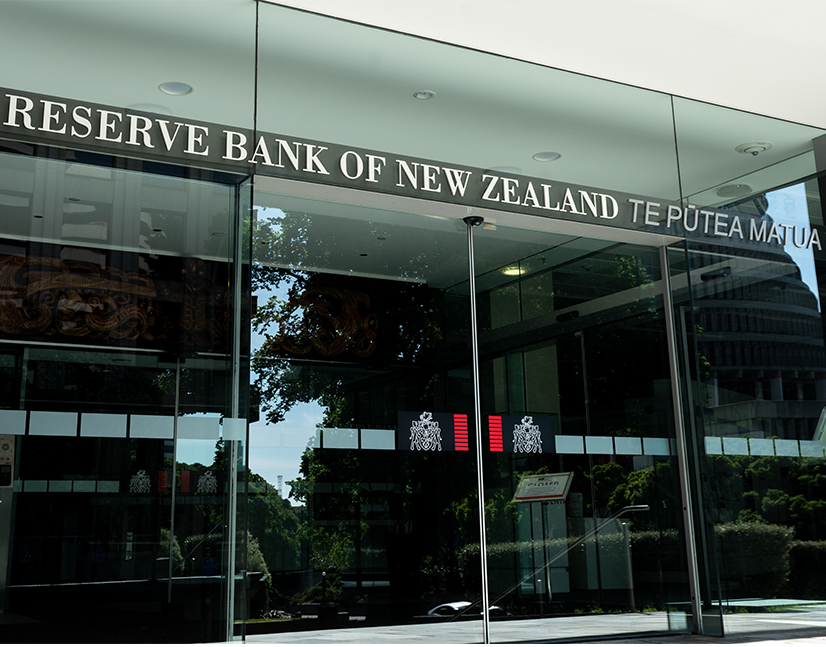
New Zealand market leaders look to a future in flux
KangaNews hosted its annual Women in New Zealand Capital Markets roundtable discussion on 24 March, in the immediate wake of local climate events and global banking risk that put the market on high alert. Participants discussed the impact of a changing world and how New Zealand is responding to a raft of challenges.
NATURAL DISASTER AND THE ECONOMY
Swiss How might the recent extreme weather events in New Zealand influence the Reserve Bank of New Zealand (RBNZ)’s battle with inflation?
RAYNER The RBNZ released its February monetary policy statement shortly after the weather events. At that time, we noted that there will be short-term disruptions to employment, trade and production. Over time, however, the recovery and rebuild phase will add to economic activity.
The weather events are likely to contribute to inflationary pressure in the short term with the medium-term impact on inflation more uncertain. The degree to which monetary policy will need to respond will depend on the scale and funding of the rebuild and recovery, the impact on the productive capacity of the economy and the extent to which short-term price pressures translate into more persistent effects via wage setting and inflation expectations.
The RBNZ will continue to examine the data, talk to businesses and engage widely to continue to better understand these impacts.
The monetary policy committee (MPC) takes a medium-term view and makes decisions on the basis that monetary policy has long and variable lags. In February, the MPC decided to look through the expected short-term impacts and focus on the likely medium-term impacts on inflation and maximum sustainable employment.
In February, the OCR [official cash rate] was projected to peak at 5.5 per cent, which was unchanged from the projections in November – though noting, again, that this was very early days following the weather events and the wider consequences were unknown at the time. An update to the RBNZ’s assessment of the impact of the weather events will be incorporated in the monetary policy review on 5 April.
Swiss Are there lessons that can be learned from the Christchurch earthquakes or is this acompletely different set of circumstances?
RAYNER The starting point of the economy was quite different for each of these two events. There was a significant amount of spare capacity in the economy following the Christchurch earthquakes, whereas now we have a tight labour market and broader capacity constraints, which have contributed to current high inflation.
These existing capacity constraints could mean that any rebuild activity may be more inflationary than previous natural disasters. Capacity constraints may also mean it takes longer for recovery work to get under way and be completed.
The RBNZ has tightened monetary policy significantly over the last 18 months. This is expected to slow demand in the economy, which may enable resources to be redirected to flood-affected areas. An example of this is the construction sector, where activity had been projected to slow considerably over the course of the year even prior to the weather events.
BOYLE Another key difference is the characteristics of each affected region. Christchurch is a city and Napier-Hawke’s Bay is more agriculturally focused. There are similarities like arterial routes and key infrastructure that will need to be rebuilt. But Christchurch was predominantly a rebuild of a city centre.
We are not sure how long the land remediation required in Napier and Hawkes Bay could take. There are currently 80,000 insurance claims for the cyclone, versus 650,000 claims for Christchurch. While the cyclone was devastating for a number of communities, physical impacts on buildings were comparatively fewer than in the earthquake: 7,000 homes had to be demolished in Christchurch’s central business district area, compared with 2,000 yellow stickered and 450 red stickered claims in Hawke’s Bay.
Longer-term, however, the land remediation factor is driving questions about whether the land is usable and how long a remediation process would take. The time horizon is unknown.
DODDRELL As we saw during the Canterbury rebuild, reconstruction is likely to take an extended period to complete. We will also need to think about whether we should rebuild in the same place, for example, taking into consideration ongoing flood risk and cost of insurance. This increases the difficulty of understanding how many homes and how much infrastructure will be built. Long-term assessment will be needed to answer this question.

Swiss There was growing concern in 2022 about an emerging wage-price spiral inNew Zealand. What are the RBNZ’s latest observations?
RAYNER In nominal terms, wage growth has continued to increase over the past year. However, people who have stayed in the same job have generally experienced their wages not keeping up with inflation. There have been other ways in which workers have obtained higher wages – including movement across employers and asking for more frequent wage increases. We have seen that people have been moving jobs at an elevated pace, consistent with labour shortages and strong demand in the economy.
The tight labour market has been a constraint on activity, which has contributed to heightened wage inflation. Heightened wage inflation can increase the risk of more persistent inflation. Tightness in the labour market is one of the key reasons why the RBNZ has continued to increase interest rates to ensure we can meet our inflation and employment objectives over the medium term.
Port How does net migration factor into the RBNZ’s thought process? How much extra labour capacity will there be and how will it affect the outlook?
RAYNER I don’t have the numbers in front of me, but higher immigration would be expected to increase labour supply while at the same time it also adds to economic demand. While net immigration supports stronger activity, it is not easy to identify the net impact on inflation, given immigration adds to labour supply but also increases demand for housing, transport, and infrastructure. In general, though, immigration has tended to be mildly inflationary in New Zealand in the short-to-medium term.
PORT One of our economists suggested the average age group of people migrating to NZ is 25-35. With their skill sets, it is likely many will have organised jobs in New Zealand or are well-set to be employed.
DODDRELL New Zealand was one of the later countries to open its borders during COVID-19, which drove foreign labour to other countries. While New Zealand is an attractive place to come and work, finding workers is challenging as New Zealand is globally remote – the cost, ease and convenience of returning home are viewed as considerable hurdles.
Swiss Is New Zealand at risk of having more people without their own financial safety net?
DODDRELL Inflation is affecting people’s disposable income. Canstar put out a report this week that said a quarter of New Zealanders are not saving a cent – they are living pay cheque to pay cheque. New innovation such as micro-investing platforms can remove some of the barriers to investing, by simplifying the language and eliminating minimum size requirements. This can assist marginalised savers and investors who are usually overlooked.
Westpac’s Māori strategy and inclusion team believes apps like Sharesies can be a more realistic option for people with limited funds, as they facilitate savings and small investments. Banks need to focus on these people and ensure they have the skills to help them build a financial safety net, and it will be interesting to see how technology can help more marginalised investors save and invest their money.
RAYNER Mortgage rates are often the focus when the OCR increases, but the impact on deposit rates is another important transmission channel for monetary policy. Higher deposit rates encourage saving, which is desirable as it reduces demand and inflationary pressures. Deposit rates have increased materially over the past 18 months, but they are still lower than what we would expect based on the historical relationship between mortgage, wholesale, and deposit rates.
During COVID-19, a lot of people shifted their money into at-call deposits. We are starting to see a shift back into term deposits. The MPC expects deposit rates to increase further over the coming year, incentivising savings and further dampening inflation.
MINHINNICK For many investors, the current and coming period may be the first time in their lives that they experience a bear market and potentially recessionary conditions. It is important that, through this period, investor education continues and that everyone understands the importance of saving and investing through bull and bear cycles. We are keen to see more businesses setting up superannuation schemes alongside KiwiSaver.
To the extent that people can contribute to both, KiwiSaver savings can be allocated toward retirement and superannuation saving can be used as a voluntary contribution that can be used or allocated more flexibly. Platforms such as Sharesies are also a fantastic and easily accessible option for people to invest any quantum of money when they can.
CAPITAL MARKETS
Craig How resilient is the New Zealand capital market proving to be to the recent risk events at home and globally?
NG The New Zealand retail debt market grew and functioned through the global financial crisis – it was for a time the only functioning credit market, globally, along with US private placements. This resilience has come through our market again, and it has shown its ability to adapt.
There is always a relative-value question, for institutional and retail investors – for the latter in particular as term deposit rates continue to increase. But the liquidity pools remain, and they need to be put to work. Current coupon rates provide a viable income for investors, from stable companies with strong credit ratings and investment-grade metrics.
The market has adapted to volatility with shorter execution periods and retail-investor-focused mechanisms like minimum interest rates as it navigates around new data and headlines. The retail market is also maturing, for instance with the continued growth of retail advisory networks. It used to be purely focused on outright yield but it is becoming more balanced with an increasing focus on credit spreads.
There are strong signs that the New Zealand market will continue to show resilience and will not stop at the first sign of trouble.
MINHINNICK The New Zealand listed market is proving to be quite resilient at present. We had NZ$20.9 billion (US$13 billion) of capital raised on market in 2022, which was more than any other year since 2015.
We have also had a strong start in the first quarter of 2023, with many deals coming to market. There was a pause period in March as debt issuers evaluated the effects of the SVB collapse and the risk of contagion in the financial sector offshore, but we have since seen quite large bond deals launch and price – so things appear to be stabilising.

Craig How have banks gone about shortening retail execution windows?
NG Retail deals used to open on a Monday and close on a Friday, or even on occasion stay open over a weekend. Wholesale trades have always been quicker – sometimes intraday. They now tend to have a shorter execution window especially in the context of data prints or market volatility.
The QFP [quoted financial products] regime allows lead managers to shorten execution periods for repeat issuers and for transactions to clear the market in less time. This has been key given the narrower execution windows of late.
PORT A minimum coupon is helpful in this context. It removes the downside risk around the coupon setting at a lower value than when the investor assessed value early in the offer period.
DODDRELL I think it is interesting that COVID-19 gave us a playbook on how to revive issuance and how to operate through periods of short-term volatility.
Preparation is critical as execution windows narrow; if a deal group is not ready to go it may not be able to take advantage of a small window. I agree with Hannah: minimum coupons are helpful as they can support demand through rates volatility. We also have the advantage of the pre-offer, which we are using in the current market conditions. Investors definitely triage information that comes across their screens and it is helpful to be in market with an announcement in order to get their attention.
Additionally, there are times in which we need to hit pause on primary activity. The good news is that we now have the script for reopening when these periods of heightened volatility pass.
NG It is challenging to be the first market to open, globally, on a Monday morning – we are trying to get to grips with various trader opinions and the reality is that it can be limiting if we continue with the norm of opening retail transactions on a Monday morning. We have to acknowledge that flexibility is crucial in a volatile environment and the data is increasingly influential to the New Zealand market given the overlay of international noise on local markets.
PORT Another factor we have to consider is that there is a lot of demand to access the market, which means fitting everything in is a challenge – and doubly so in an environment where every event is a live one and there is constant headline risk.
This makes the pre-offer process even more important: to fit issuers in and also to manage issuers’ awareness if there will be multiple transactions in progress. It can be done, but it is a relatively new dynamic in our market.
NG This is right. Historically, retail channels have been resistant to having two retail bond offers in the market at the same time. But there has been a shift to try to put more in the market, especially because windows are narrow.
Craig Do dealers have to be careful about the type and name of credits when running simultaneous deals?
PORT It is important to be careful to avoid potential conflicts. While the exact timing of execution is not within a lead manager’s control, we’re always conscious of executing well and achieving issuers’ objectives.
DODDRELL Reduced execution windows result in issuers targeting the same periods for issuance. However, sufficiently different credits can be executed concurrently. The Contact Energy and Christchurch City Holdings transactions are recent examples, noting they are in different rating bands and were targeting different tenors.
BOYLE CBA [Commonwealth Bank of Australia] has robust policies and procedures to manage sensitive information and potential conflicts. Where there is no potential conflict, we are encouraging issuers to access the market and take advantage of issuance windows when they arise. Issuers that accessed the market before the SVB and Credit Suisse events will be pleased with their decision.
Financial sector under the microscope
The main market talking point in late March was the collapse of Silicon Valley Bank (SVB) and Credit Suisse. While the impact was felt around the globe – and New Zealand was no exception – the consensus seems to be that no radical path adjustment is needed.
RAYNER We have been monitoring global banking issues closely and are in regular contact with other central banks and regulators. We are confident that the banks we are responsible for regulating and supervising in New Zealand have sound liquidity and funding positions.
The recent global developments will be discussed in more detail in our April monetary policy review and financial stability report, published in early May. However, it is interesting to note that in recent days, following developments with SVB and Credit Suisse, the Federal Reserve and the Swiss National Bank have remained committed to combating inflation and have continued to tighten monetary policy.
Low and stable inflation is critical to the pursuit of our economic and financial stability objectives. There has been a slight tightening in credit conditions as a result of recent banking developments, which may affect the degree of monetary policy tightening required. But it is still too early to tell at this stage.
SUSTAINABLE DEBT EVOLUTION
Swiss Did New Zealand Debt Management (NZDM)’s green bond attract new investors? How is participation – and pricing – in the line?
CLARKE We consider it a very successful transaction. We issued the maximum we wanted to issue at the tightest price point from the initial guidance. We haven’t commented on any ‘greenium’ at issue beyond saying we were happy with the spread and believe the deal offered good value for everyone.
At this stage, the green bond is priced at more or less what we would consider fair value – there doesn’t seem to be a greenium. But we don’t have any issue with this. A greenium was only a supporting factor for issuing green bonds – it was the monitoring and reporting attached to green bonds, as well as contributing to development of sustainable finance markets in New Zealand and to investor diversification, that were the most important advantages of green bonds.
We treat green bonds the same as conventional nominal bonds, with the same line sizes. But we will monitor to determine whether the nominal and green lines exhibit similar liquidity characteristics, given there are typically more buy-and-hold investors for green bonds.
DODDRELL Having seen the amount of work NZDM put into the preparation and marketing of the green bond, it struck me that it would not being doing this for one or two basis points. This reflects the view of the majority of issuers that Westpac works with when establishing a green-bond framework. For issuers, it is about expressing who they are as organisations and their approach to sustainability.
‘New Zealand Inc’ receives significant benefits from what the government has done and is doing. I am sure NZDM has had a very positive reaction to the green-bond framework from issuers and investors. As the government issuer, NZDM can bring light into areas like biodiversity as well as providing a line of sight for other issuers on constructing a framework and the categories included within it.
NG In roadshows and one-on-one investor meetings nowadays, a lot of questions are concerned with the sustainability actions and direction taken by issuers and companies. This does not just apply to green bonds – it includes all aspects including social elements and governance. These discussions are happening and they – and the market as a whole – have matured since the first green bonds.
PORT Sustainable finance is not usually the first step on a sustainability journey – it typically comes after a strategy is formed. That said, it can be the catalyst for finishing a strategy. Many issuers want to do sustainable finance, but it is not always immediately possible. It can be helpful for a company to make it known that it is working on, or going through, transition and articulate the ways it is striving for and effecting change.
Swiss Greenwashing is a subject of increasing regulatory focus in global markets. What is the situation in New Zealand?
MINHINNICK In the listed market, 2023 is the first year where there will be mandatory TCFD [Task Force on Climate-related Financial Disclosures] disclosure for companies with a market capitalisation of more than NZ$60 million. This is an equity issuer requirement, though most New Zealand debt issuers are already listed on the equity market. It will standardise ESG [environmental, social and governance] disclosures across the market over time as companies become more used to the reporting regime.
Anecdotally, we are also hearing that in jurisdictions where there is not yet mandatory ESG disclosure, investors are increasingly asking for this information to be provided voluntarily to assist with their allocation decisions.
DODDRELL Greenwashing is definitely a theme. There is an increase in regulation and pressure on companies to disclose and report on their ESG policy, strategy and targets. We are also watching the greenwashing cases that are occurring in Australia.
There is also a question about whether sustainability takes a back seat due to inflation and the fallout from the SVB collapse. However, while certain aspects may change, sustainability is a juggernaut for business. It is, quite frankly, an issue they simply cannot afford to ignore. We are of the view that sustainability remains a key focus and driver for business, irrespective of inflation.
A strong sustainability strategy mitigates future risk and it is part of the conversation when we talk about a business’s financials and overall strategy.
BOYLE We also have strong momentum due to legislation, and in New Zealand it is a bipartisan issue. This means we are already quite green at least in the sense of our use of natural resources.
Greater scrutiny over perceived greenwashing may temper growth of ESG issuance, though. In the debt capital market, sustainability-linked bonds tend to receive the most focus given investor scrutiny on targets – and we have seen a significant decline in issuance. However, interim targets to reduce emissions are looming, and we believe this is likely to underpin investment requiring funding from capital markets.
RAYNER Given recent weather events in New Zealand, I expect more market users will be observing the link between environment events, inflation and the cost of living. If anything, this should put more pressure on our timeline for adaptation.
DODDRELL The cyclone is one of many climate crises happening around the world, and ideally inflation and the climate crisis should not be pitched against each other. There is an undeniable tension in individual consumers’ engagement with sustainability and affordability. They want to do more for and be more mindful of the planet and environment, but the cost of living prevents them from doing so.
On the other hand, inflation is creating a time for people to reflect on their purchases and consumption behaviours. We are hearing about an interesting pattern of behaviour in which consumers are making choices and favouring solutions that are similar to circular economy principles. This means anything that makes better use of existing resources and avoids waste, which is helping accelerate the transition toward more sustainable consumption.
Ultimately, though, addressing the climate crisis will fall not just on consumers but on governments, organisations like the United Nations, and corporates and businesses. At times where consumers may have to stand down, we – representing corporates and businesses – will need to stand up.
PORT Roughly 80 per cent of funding needs to come from private sources to achieve global climate targets. We genuinely cannot afford to drop the ball.
BOYLE New Zealanders are, in general, aware of the carbon market. Our emissions trading scheme is robust. There is always debate about how credits are awarded and their worth but New Zealand’s are well-established and understood. The established trading scheme combined with the other points we have discussed makes me confident there would have to a significant ‘stop work’ to slow momentum domestically.
DODDRELL In respect of sustainability in New Zealand, we have more work ahead of us. Younger generations – those entering the workforce now – possibly have a better grasp on these topics than we had. I hope the next generation can pick up and run with it at a quicker pace than we did.
BANERJEE Earlier this year, I participated in a roundtable with university students and early career starters that discussed a younger person’s perspective on investing. This was through my role in INFINZ Young Women in Finance (YWF). The trends that came out were surprising and not so surprising.
Sustainability as a key driver behind investment decisions was a big theme, particularly among the younger woman, even when sustainability reduces financial outcome. They took a long-term view, knowing sustainable investments can take longer to pay off. The younger men in the roundtable listed sustainability last in their investment choices, though our subsample was small: five or six people across all of New Zealand.
RAYNER In the context of our objectives at the RBNZ and our climate change strategy, we can help foster an orderly transition by getting the right foundations in place. For example, we are working closely with banks and insurers to ensure they understand and manage their own climate-related risks and help facilitate the flow of capital to support the transition to a climate-resilient economy and financial system.
While many individual institutions are making significant progress in this space, the RBNZ has a role to play to ensure climate risks are considered and managed consistently across the system.
The RBNZ is also working closely with other financial regulators to support the mandatory climate-related disclosure regime that is being led by the XRB [External Reporting Board] and the FMA [Financial Markets Authority].
We are also collaborating with industry in the development of climate stress test scenarios. The aim of this exercise is to find out more about the impact of physical and transition risks, and to help build sector capability.
The RBNZ purchased a small portion of NZ government-issued green bonds, primarily to help facilitate local capital market development and to support our domestic liquidity management operations.
Finally, we are keeping a close eye on the work being undertaken by the Network of Central Banks and Supervisors for Greening the Financial System and the Bank for International Settlements to evaluate how sustainable investment can be incorporated into central bank foreign reserve holdings. We welcome this work, especially in relation to providing suitable metrics and measurement consistency to allow us to consider how we can include sustainable investments on our balance sheet without compromising our liquidity and safety mandates for foreign reserves.
Sovereign sector in focus
New Zealand’s sovereign borrower has experienced some major developments in the past year, most notably its debut as a green-bond issuer and inclusion in the World Government Bond Index (WGBI).
CLARKE We identify possible execution windows well in advance when we are considering a syndication. This helps us to avoid event risk. When we believe the time is right to go, we try to take the earliest clean execution window available. In hindsight, we are pleased with the [early March] window we took to syndicate our new 2030 bond. If we had waited we might have had to consider delaying until market conditions stabilised.

Foreign holdings of NZGBs have increased by NZ$18 billion in the past 18 months and, at NZ$66 billion total, they are at their highest level ever. There are plenty of possible reasons for this including relative value, inclusion in the WGBI – which has definitely brought a few participants into our market – and our high volume of issuance.
Swiss Increasing attention is being paid to the concept of ‘greenhushing’. How can the market ensure there is integrity and credibility in the ESG space without hindering transition?
DODDRELL It is not helpful for companies to be in a permanent state of fear and it is important to strike the right balance. We have international guidelines and standards to align to, such as ICMA [International Capital Market Association] and CBI [Climate Bonds Initiative], as well as verifiers and second-party opinions. Good issuance done well, which aligns to global principles and is appropriately verified, will help demonstrate best practice and ensure credibility.
On the other hand, if we ‘wait for great’ nothing will happen. This area will continue to evolve, and temperature and emissions targets will continue to be updated, so we may need to move harder, faster and more aggressively. Frameworks that were set up five years ago may have been the best at that point in time but may no longer be aligned to best practice. Everything is subject to ongoing review.
Companies are very keen to engage and demonstrate best practice. The last thing we want to do is create fear, leading them to do nothing.
PORT If we insist that everyone needs to be at the gold standard from the outset, we risk discouraging some from even starting. But, at the same time, we need integrity – if we are going to do something, we need to do it properly. It is a balancing act.
Craig Can we be confident there are enough well-qualified verifiers to ensure the market is maintaining integrity?
DODDRELL The acceleration in sustainable finance has been great to witness. However, an unintended consequence is, as you say, an insufficient number of skilled people to fill all the roles. Within our own organisations, we would all like to find people with these skill sets – and we are in competition with corporate New Zealand, which is targeting the same people.
It is good to see that young people view sustainability as an interesting subject to study and a worthwhile career, and I genuinely believe we will see more people come through with the appropriate skill sets. Ultimately, I believe sustainability will be so ingrained in any kind of role that everyone will have a strong understanding of the topic.
PORT It is important to embed this culturally in all levels of all organisations, and everyone needs to be working toward embedding this. It is the trickle-down effect – if everyone is aware of and talking about it, it will more effectively bring about change.
DE&I UPDATE
Craig The post-pandemic recovery continues to play out. Have New Zealand organisations finally settled on what the future of work looks like?
CLARKE At the Treasury, even before the pandemic, flexible working was offered by default – but no-one really took advantage of it. Since the pandemic, people have started to work from home more regularly. There are clear benefits to being in the office and employees are encouraged to be there three days a week. I personally work from home about two days a week, which is viewed as very normal.
BOYLE CBA also had a flexible working policy prior to the pandemic. The idea of social cohesion and ‘glue days’ really demonstrates the importance of being in the office and highlights the value of connection.
Different ways of working are guided by individual business units. Regardless, though, for younger and newer team members it is difficult to get past the helpfulness of listening in on valuable office conversations.
NG The importance of ingesting the conversations that go on around you cannot be overstated. ANZ also offers flexible working but I estimate our team is in the office at least 90 per cent of the time, and likely even more.
Nothing beats having a face-to-face conversation and the ideas that are generated or the different ways of thinking that emerge as a result, particularly for our new graduates. This cohort found the COVID-19 lockdowns very difficult – when they were based at home they didn’t know who to call.
On the other hand, the availability of working flexibly is helpful. I would say the one good thing to emerge from the pandemic is that the ability to work from home and still be effective has been proven.
RAYNER We had flexible working arrangements pre-pandemic, but I’d say the experience of the COVID-19 period has ‘normalised’ these arrangements. Our people across Wellington and Auckland are better connected, and we also have other staff working from other parts of the country.
Workplace flexibility is essential when it comes to attracting and retaining the best talent. While there are many benefits, there are also challenges that need to be managed. For example, creating an inclusive work environment and ensuring everyone feels a sense of belonging, and managing the risk of proximity bias.
BANERJEE Post-pandemic, there has been a huge surge in people opting to work flexibly – and this extends to early career. I have seen my own peer group opting to work either completely remotely or in a hybrid fashion, because they are conscious of housing affordability or taking advantage of the borders opening.
The organisations that offer this kind of flexibility are more likely to retain staff. We hear about the difficulty of retaining 25-30 year olds because, now that they are able, they are choosing to spend time overseas. Flexible working from overseas is an opportunity to help retain staff.

NG I think it very much depends on the type of role. Our roles require us to spend some time in the office. We manage teams in other cities, though, which isn’t very different from managing someone working remotely.
DODDRELL I agree. I think it depends on the area in which you work and I also choose to spend most of my time in the office. However, we don’t measure who works where, for what hours or why. Without doubt, this will have more of a focus going forward.
I read recently that companies are collecting data on employee productivity, performance and morale, to help them identify any employees working remotely that may require additional support.
The concept of what it means to be working in a hybrid fashion will continue to evolve as we collect more data on the outcomes – good and bad. One way or the other, though, hybrid working is here to stay.
Craig Is there any data to support the idea that flexible workplaces attract a wider variety of people?
RAYNER We can certainly observe the benefits, even if it isn’t easy to measure through data. The key to sustainability and having a positive long-term impact on organisational performance and employee experience is having a multilayered approach. This approach should be focused on representation – including hiring, promotions and the composition of decision-making committees – and inclusion, including day-to-day experience for staff, behaviours, culture and psychological safety.
Attracting diverse talent is just the beginning – for retention, we need to ensure we create a culture where people feel comfortable bringing their full selves to work every day.
NG More than ever, when people are looking for jobs they are conscious of their values aligning with the values of the company.
DODDRELL For some young people, working from home may involve sitting at the bottom of their bed with their legs jammed under a table, with three other flatmates who are also working from home. They would really rather be in an office and they don’t necessarily need flexible working. But then the same people will hit a life stage where flexibility becomes more important – for example, when parental leave comes into play.
The benefits of hybrid working may take a long time to be fully realised, because it is only at certain times that people will reap the benefits.
Craig A European higher education provider recently decided it would interview only women for jobs for a period of 18 months. What do participants think of this approach to improving representation?
DODDRELL Women should not be hired solely for the purpose of improving diversity. Hiring decisions should be based on a candidate’s qualifications, skills, experience, and potential to contribute to the organisation’s goals and objectives.
Having said this, sometimes we must make hard decisions to get to the best outcome. What you mention is extreme, but I think it is an interesting concept to debate.
NG Diversity also encompasses more than gender. It is really about diversity of thought, which is hugely valuable as a way to achieve the best culture. A workplace made up of copies of the same person is a recipe for disaster.

RAYNER If we take a very narrow view, we run the risk of creating other imbalances or setting people up to fail from the beginning. Given the types of skills and experience we need at the RBNZ, one of the challenges we face is that our pipeline for some areas is driven by study decisions at school and university. This is a longer-term challenge and we are thinking about how we can influence the supply of talent – which needs to be addressed more holistically than at the recruitment stage.
DODDRELL It comes back to culture. While diversity is important, interviewing only certain groups feels like a box-ticking exercise as opposed to truly addressing the issues related to why we have an imbalance.
PORT Very aggressive quotas may also alienate existing support in the workforce. Unreasonable policies are unlikely to be widely supported and are therefore less helpful to the overall objective.
RAYNER There are many more useful things we can be doing to attract a broader range of talent. There are ways to promote our industry, for example increasing engagement via universities and secondary schools, and through channels such as INFINZ YWF. We also need to look at our recruitment strategies, culture and other potential barriers or biases that are preventing us from having a better mix of diversity within our organisations.
BANERJEE I fully agree that it is one thing to bring women into roles and quite another to retain them by having an inclusive culture that encourages them to stay, particularly bearing in mind biases created by existing employees.
A parallel that comes to mind is backlash around the requirement for Maori doctor quotas. We would hate to see a recurrence of the kinds of conversations this produced come into the financial services sector.
DODDRELL It is a complicated problem and interviewing only woman is too blunt a tool. I understand organisations have targets – we do at Westpac. But the targets exist to ensure the focus is there.
BOYLE It is important to have targets but it is equally important to measure progress along the way, at different levels across the organisation. One of CBA’s targets is for 47-50 per cent of executive manager and above roles to be female. This kind of moving target at senior level sets the right tone.
It is a requirement at CBA to have 40 per cent female, 40 per cent male and 20 per cent any gender at board level. There is definitely a balance and there are goals, and it is powerful to see this implemented throughout the organisation. This data is included in our annual reports, which is also powerful.
Rayner What pipeline of talent is the YWF network seeing and what can the industry do to increase it?
BANERJEE The starting point for the YWF network in Wellington is that we are a minority of a minority of a minority, in that we are young women working in finance based in Wellington. Our membership base is growing, largely with university students from Victoria University of Wellington, which is incredible to see. However, we are also observing an exodus as younger female professional members move overseas. We expect this to continue, particularly through to the end of this year.

Swiss In 2022, the gender pay gap in New Zealand was around 10 per cent according to Employment New Zealand data. Is this mirrored across the organisations here?
RAYNER Addressing the gender pay gap requires a multidimensional approach. This includes improving our data collection, analysis and reporting so we continue to build our knowledge and awareness of what is driving the gap, targeted talent and leadership initiatives, training to address some of the ‘unexplained factors’ that may contribute to our pay gaps including unconscious bias, cultural competency and cultural intelligence training and inclusive recruitment practices.
With regard to targeted development, the RBNZ recently launched a pilot women in leadership programme. The objectives of the programme are to provide participants with targeted development options, networking opportunities and exposure to senior leadership, to empower and enable participants to achieve their leadership aspirations, and to build a pipeline of women who are ready to apply for senior roles when they become available.
DODDRELL It is positive that our gender pay gap is heading in the right direction. However, the speed of change in banking remains small, at about a 1 per cent reduction each year. This excruciatingly slow pace reflects the changes we all face with the gender pay gap, largely reflecting historical characteristics that are common to our industry.
Similar to the RBNZ, at Westpac we also use mentoring. We see it as an effective tool but we need to do more if we are going to close the gender pay gap.
MINHINNICK NZX’s aim is to have at least 40 per cent women and 40 per cent men in each workforce group. Increasing the number of women in senior roles remains a priority. Our senior leadership team is getting close to achieving 40 per cent women executives, and we actively participate in industry groups such as Champions for Change and Global Women.
We are working on reducing our mean gender pay gap from 14.7 per cent and have set a target for 2023 to get down to 12 per cent. Obviously, it would be ideal to eliminate the gender pay gap entirely as soon as possible.
Rayner At this forum over the past few years,we have talked about collectively wanting to have an impact on diversity in our industry. But we have not yet put a plan into action. What can we collectively do to help shape the future in a positive way?
DODDRELL I went into a school recently and heard the principal tell a group of girls that while a man will be paid for the full year, because of the gender pay gap a woman will be paid to 28 November. If you are Maori or from the Pacific Islands you effectively stop getting paid on 4 November. Not only is this a terribly confronting and impactful statement, but it is also very difficult to form an argument against it.
I agree that next year, as a group, we should come together to be held accountable to an action plan. The more we engage all of society, the greater the likelihood of change.

HIGH-GRADE ISSUERS YEARBOOK 2023
The ultimate guide to Australian and New Zealand government-sector borrowers.

WOMEN IN CAPITAL MARKETS Yearbook 2023
KangaNews's annual yearbook amplifying female voices in the Australian capital market.













